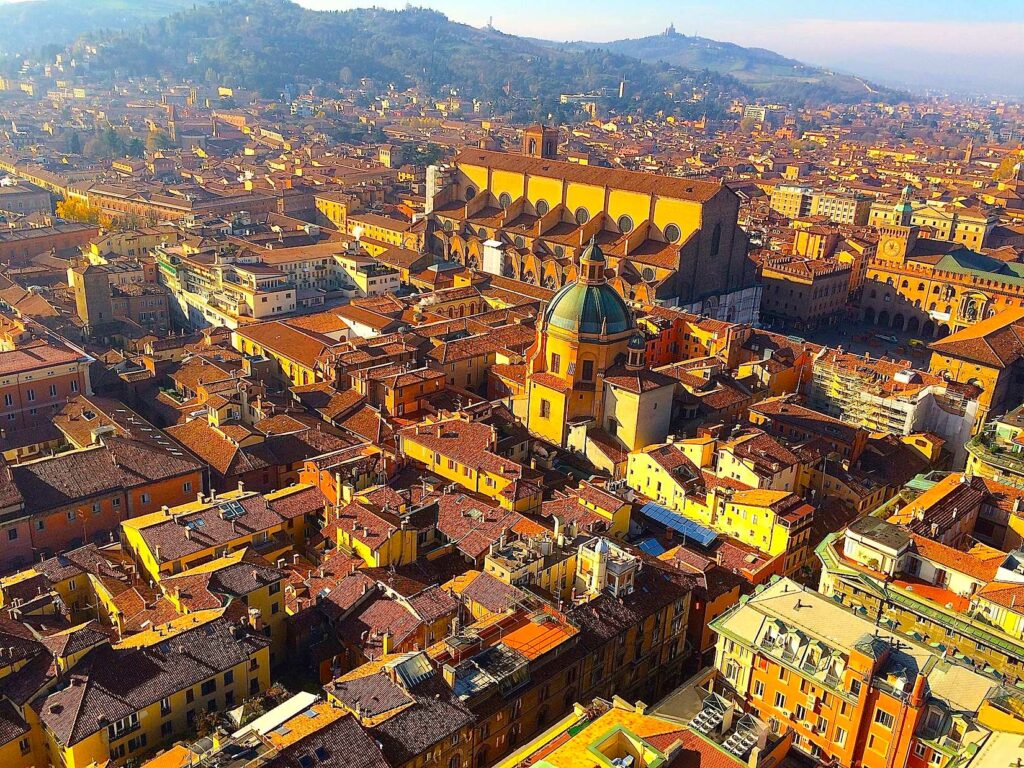
That’s Shakespeare in Hamlet not me, OK?
But I did just that and hopped onto the Fressiarossa from Milan to Bologna and soon entered Il Convento Di Seta Fiori (“The Convent of Silk Flowers”) for a night (or two). It’s a 16th building located within the old city walls of Bologna, Italy, which has been affectionately converted into a boutique ten-room hotel. My room was carved out of the nave of the church. From the curved shape of the ceiling I guessed I was sleeping roughly where the altar once was. The ceiling stretched off into heaven and that night I slept like, well, the angel I never was (or will be).
Bologna, Italy is one of those places you have probably flown over, driven past or trained by on the Fressiarossa as you sped off to Rome, Florence or Venice. By doing just that you may have missed one of the most interesting and charming cities in Italy.It feels more like a town than a city and is home to the Università di Bologna, one of the oldest and most distinguished institutions of higher learning in all of Europe. Founded in 1088 this university had students wandering its campus 100 years before the Magna Carta was signed at Runnymede Meadow and nearly 400 years before Columbus set sail for the new world. For street cred all you have to know is that Nicolaus Copernicus is an alumnus.
In 1588, one of the most inexplicable decisions ever made by a University anywhere denied Galileo’s application to become the Chair of the Department of Mathematics. Why? you might ask. Because Galileo confirmed the findings of Nicolaus Copernicus, who in 1514, proved that the solar system was heliocentric, ie. that the earth revolved around the sun and not the Vatican.
When the Pope heard that bit of annoying science, the Pope’s Christian sense of forgiveness immediately declared that Galileo should be separated from his head. Before that could happen, Galileo wrote a papal apology admitting he had erroneously used “feet” instead of “meters” in his calculations. “Sorry,” he wrote, “the sun does revolve around your Holy Eminence’s Holy Eminence!” That letter was lost (by the way).
In 1615, four hundred years after Galileo was required to appear at an Inquisition in Rome to defend himself as a heretic, Amazon sold its 1 billionth “selfie-stick” proving undeniably that the world had repudiated Copernicus’ heliocentric theory in place of our own singular narcissism. The world now revolves around each of us.
Bologna has an estimated 25 miles of porticos to protect you from the sun or rain or snow or whatever inclement weather northern Italy might throw at you. These covered arches are not simply functional structures. So instead of looking down at your phone’s GPS display look up at the wonderment suspended above you. Floating overhead are cherubs, flower garlands, bouquets displayed in Roman vases, miles of multicolored ribbon, Roman ladies lounging and Roman men drinking, the heavens with its stars and moons, birds flying freely and in cages, fauns (Roman mythological creature that is half-man, half-goat), winged dragons, and all imaginings of adorned women and men at rest and play.
To this day the porticos of Bologna occupy the intersection of art and function. At the end of the 13th century the city fathers passed a series of laws not the least of which was to set the minimum height of the arches at seven feet. As everyone knows, this allowed a man on horseback to ride comfortably beneath the archways. I believe that horseback riders are no longer permitted under the porticos but this is just an educated guess.
Architecture aside, more than one writer has referred to Bologna as the “Stomach of Italy.” Bologna is situated at the heart of the Emilio-Romagna Region, which produces the trifecta of Italian cuisine: Parma Prosciutto, Parmigiano-Reggiano cheese, and pasta.
Convinced yet?
Forget the bologna and cheese sandwiches your mom made for you for much at school. Try the Pasta Bolognese at any café. You’ll thank me later. Guy Sibilla


